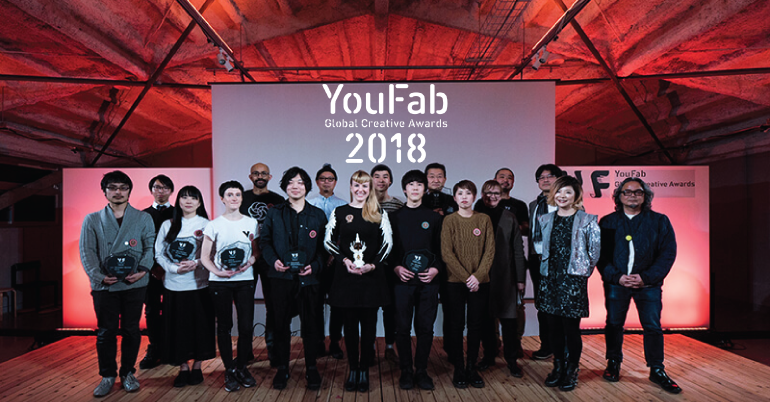YouFab is calling for entrants from all over the world for YouFab Global Creative Awards 2018 to show us how you nail the art of fabrication. They want to challenge the idea of sensible, defying sound judgment and “hack” common sense. Y0uFab is looking forward to seeing entries that align with this spirit and are looking to support such works. Even if the output is in its drafting stages YouFab will evaluate the attempt and future potentials of the work.
This year’s theme:
When 3D printers became widely known around the world, one first reaction was that people started to think, “From now on, we’ll be able to make anything with digital fabrication!” The first thing that then caused unease was the idea that idiots would use digital fabrication to make guns. And indeed, 3D printed guns appeared immediately. And they were certainly capable of killing. That being said, if the highly valuable 3D printing technology was only being used to industriously produce some sort of equipment for violence, it would make such new technology untenable. I understand that the YouFab Award was established with the mission of spreading digital fabrication around the world, not as something which supports violence, but rather as something which supports a new “aesthetic”. I believe it’s an honest mission.
I think this mission can be looked at in yet another way. With digital fabrication and the “democratization of manufacturing” brought about by it, if anything, the fact that anyone can make a in and of itself is valuable. And I think it may continue to be valuable. That being said, I don’t wish to be misunderstood. The “gun” I’m using here is only a metaphor. What kind of metaphor? For the time being, I will tell you here that it is a metaphor for “a tool for rebellion.”
The concept “making things = manufacturing” of our current industrial society came about by the leadership of various countries and enterprises with large amounts of capital. These countries and enterprises also possess technology and production lines, leading to the monopolization of the market. In this situation, consumers cannot be involved in making things for themselves, so in order to get what they truly want, the only thing consumers can do is some sort of hacking of existing goods.
However, as technology becomes more common and less expensive, Making gradually ceases to be something led by “them,” and becomes something led by “us.” The spirit at the root of digital culture, which originated with the hippie movement on the West Coast of the United States, is the dream of recreating our lives for ourselves with our own hands, using the tools we have obtained. At the center of movements for freedom and autonomy, computers and the internet are, above all, “tools for rebellion” against the government and existing industries.
Chris Anderson, former editor-in-chief of the American edition of “WIRED,” who spread the concept of “makers” to the world, spent his school days in Washington DC during the flourishing of the punk movement.
What happened during the late 70s and early 80s (actually, all over the world, and even here in Japan) was that the cost of recording equipment became something which students and young people could afford, making it possible for anyone to produce and transmit extreme hardcore music, which could have never happened in the past. As an antithesis to the existing music industry, it instantly captured the hearts of young people. In the raw sound, recorded on a cheap MTR, and in handmade leaflets printed with a copy machine, it was there in the world of DC punk that Chris Anderson says he learned all about the D.I.Y. spirit that would lead to the “makers’ movement”.
The most important thing here is the fact that thrusting an intense “NO” at the current state of existing industries and what they create will become something which can also be done by the smallest individual. This is where the value of being independent, and being D.I.Y., lies. Can we not find a sense of “aesthetics” in there too? The music of Minor Threat and Bad Brains, known as the leaders of DC punk, may have been little more than noise when viewed with the criteria of existing music of the time. However, there is also freedom in asking again if the “standard of beauty” set in the past is really the aesthetic we are seeking now.
In this way, it can be said that the essence of digital fabrication, which computers and the internet were once hoped, and expected to represent, is resistance and rebellion against authority and the current situation. A tool to dream of alternatives to the current situation. If this is the case, even if you make something with a 3D printer, unless you look at it with this attitude in mind, it makes the invaluable 3D printers untenable.
This year’s theme, “Polémica!”, emulates the name of a former collaborative project between Loftwork Inc. and the Japanese edition of “WIRED”. Polémica refers to “controversy” and “tumultuous debate”. I decided on this theme for this year’s YouFab because I would like to call for entries which acutely question the current state of affairs and present alternatives to the status quo. It doesn’t matter if it’s distorted or immature, as new questions are always unstable and give rise to a mix of pros and cons.
Why did you make what you made? What status quo are you rebelling against? What I believe needs to be challenged is the strength and depth of this questioning.
-Kei Wakabayashi
Editor
Location:
OnlineBenefits
- Grand Prize: Trophy / Prize 1000 USD
- First Prize: Trophy / Prize 500 USD
- Student Category Award: Certificate / Prize 300 USD
- General Category Award: Certificate / Prize 300 USD
- Lion Special Prize Award: Certificate / 1000 USD
Eligibilities
- STUDENT
This category is only eligible for those who are enrolled in an university or a vocational college at the time of entry. There are no age or nationality entry restrictions. - GENERAL
There are no age or nationality restrictions to this category therefore is open to anyone of interest whether it be individuals, groups or corporations. - Submissions should be creative experiments, works and inventions that stem from powerful collaborations between digital and physical fabrications. These submissions can encompass physical products, art, architecture, or intangible projects such as performing arts, events, workshops and experiments.
- A condition of entry is that the submitted work be in its completed/operational form, not left in the conceptual phase of design plans or proposals. Submissions can be something that has already been launched, or something yet to be unveiled.
Application Process
Apply online through the given link.
Application Deadline: October 31, 2018
Application ClosedOfficial link









